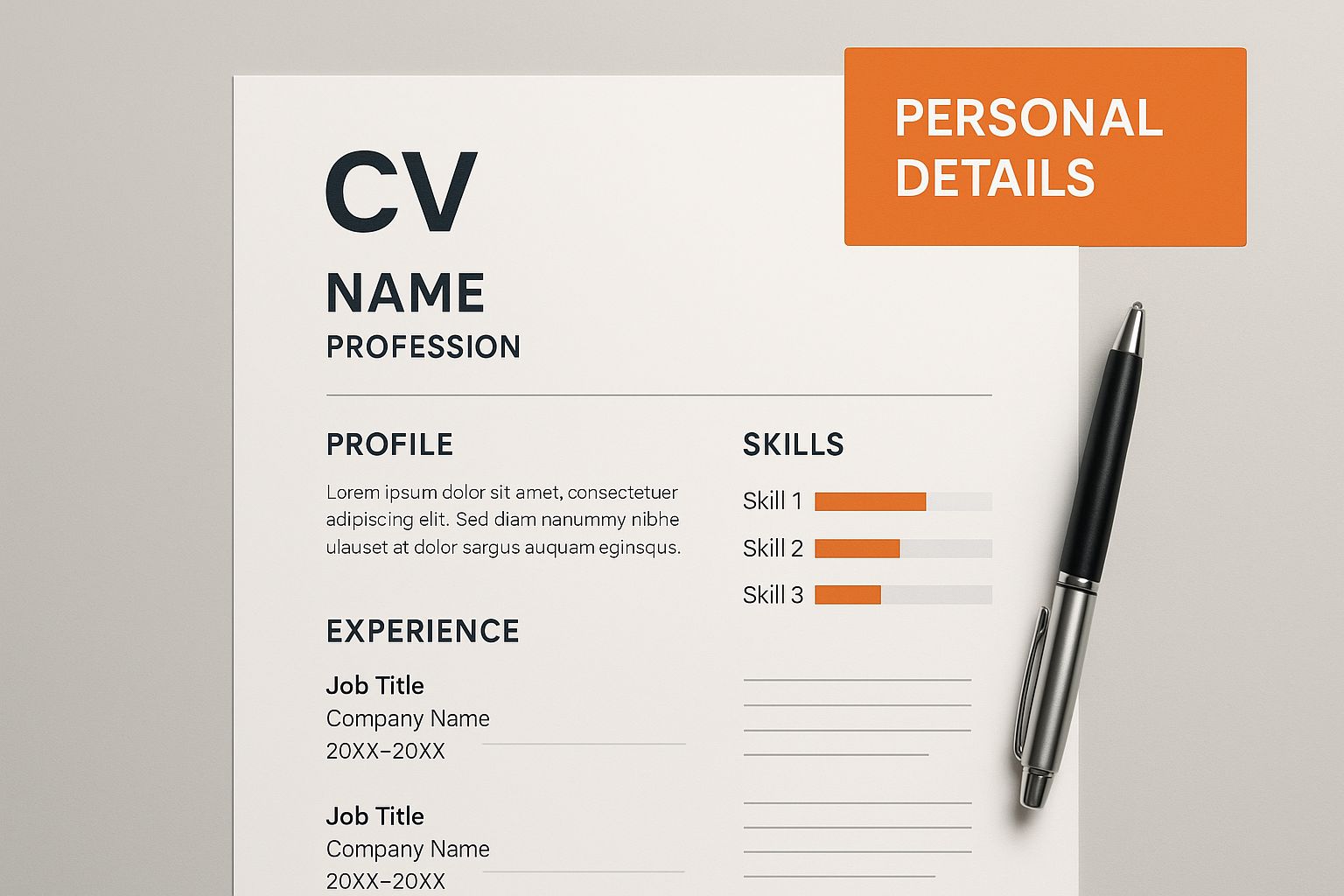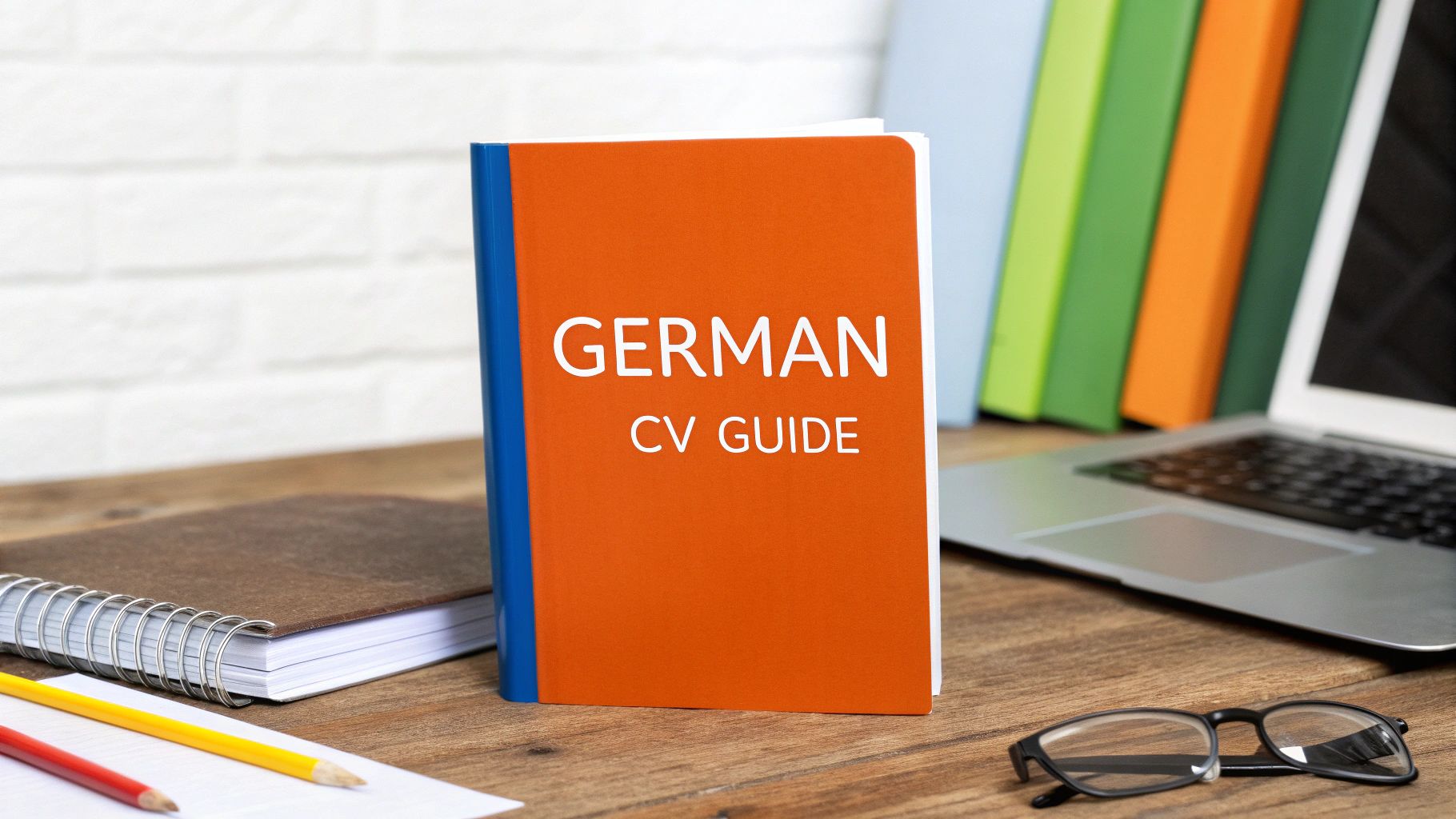If you want your CV to succeed in the German job market, you need to think less like a marketer and more like an archivist. Your German CV, or Lebenslauf, isn't a flashy sales pitch; it's a clear, factual record of your professional life. The goal is precision and completeness, presented in a clean, tabular format that’s strictly one to two pages long.
Decoding the German CV
Before you start typing, let's get one thing straight: a German Lebenslauf is a different beast entirely from the CVs you might be used to in the UK or the US. It's built on a foundation of Ordnung (order), structure, and transparency. German recruiters expect a document that's logically organised and incredibly easy to scan, allowing them to verify your qualifications at a glance.
This means you need to shift your focus. Forget the buzzwords and creative storytelling. Instead, concentrate on presenting your career path with meticulous accuracy. Every detail, from your font choice to the page layout, signals your professionalism and understanding of German business culture.
Getting the Format Right
The structure of a German CV is pretty rigid, and for good reason. Clarity and precision are everything. A reverse-chronological layout is the gold standard, making it easy for hiring managers to see your most recent and relevant experience first.
For readability, stick with classic, professional fonts. Think Times New Roman or Arial. A font size of around 11 points for the body text and 14 to 16 points for your headers works perfectly. The goal is to make the document feel serious and easy to read, not to show off your design skills.
You can learn more about the specific expectations in our detailed guide to the German CV format.
The layout below is a great example. Notice how the key personal details are placed for immediate visibility, right at the top.

When a recruiter might only spend a few seconds on an initial scan, this kind of logical structure is what gets you past the first hurdle.
To quickly see how different the expectations are, here’s a simple comparison.
German Lebenslauf vs International CV Key Differences
| Feature | German CV (Lebenslauf) Standard | International CV Standard |
|---|---|---|
| Length | Strictly 1-2 pages. | Can be 1-3 pages, depending on experience. |
| Photo | A professional headshot is still very common and often expected. | Rarely included, especially in the US/UK, to avoid bias. |
| Personal Details | Can include date of birth, nationality, and even marital status. | Limited to name and contact information. |
| Signature | Traditionally signed and dated (especially for print applications). | Not typically signed. |
| Tone | Factual, direct, and formal. Avoids "selling" language. | More marketing-oriented; uses action verbs to "sell" skills. |
| Structure | Rigid, tabular, and highly structured format is key. | More flexible formats are acceptable. |
This table really highlights the cultural nuances. What’s considered standard practice in one country could be a red flag in another.
Key Takeaway: Your German CV is less of a marketing document and more of an official transcript of your career. Think clear, factual, and provable.
The Essential Sections Every German CV Needs
To meet recruiter expectations, your Lebenslauf must follow a predictable order. While the content is all about you, the framework should be familiar to any German hiring manager.
Here are the non-negotiable sections, in the order they should appear:
- Persönliche Daten (Personal Details): Your name, address, phone number, and a professional email address.
- Berufserfahrung (Professional Experience): Your work history, listed in reverse-chronological order (most recent job first).
- Ausbildung (Education): Your academic background, also in reverse-chronological order.
- Kenntnisse und Fähigkeiten (Skills and Competencies): This is where you list your language abilities, IT skills, and other relevant qualifications like driving licences.
Nailing this structure shows you've done your homework. It makes your application easy to process and ensures your qualifications get the attention they deserve.
Presenting Your Professional Experience with Precision
This section is the heart of your German CV. It’s where you move beyond claims and provide concrete proof of your skills. Your Berufserfahrung (professional experience) will be scrutinised by recruiters, so it needs to be factual, clear, and presented with the meticulousness German employers expect.

The standard approach is reverse-chronological, starting with your most recent position. For every role, you must include your job title, the company name, its location (just the city is fine), and the exact dates of employment. This is a non-negotiable detail. A vague timeline like "2022 – 2023" just won’t cut it; you must use the month and year, for example, 08/2022 – 12/2023. This level of detail isn't just a formality—it's an early signal of the thoroughness and diligence that German businesses value.
Detailing Your Responsibilities and Achievements
Once you've laid out the basics, it's time to detail what you actually accomplished in each role. This isn't the place for a generic list of duties lifted from your old job description. Instead, you need to showcase your contributions using powerful action verbs and, most critically, quantify your achievements wherever possible. German recruiters are pragmatic and data-driven; they want to see measurable results.
Let’s look at two ways to describe the work of a marketing manager:
- Vague: "Responsible for managing social media campaigns."
- Precise & Impactful: "Managed and executed 5 cross-platform social media campaigns, increasing follower engagement by 25% and generating a 15% uplift in qualified leads within six months."
The second example is far more compelling because it doesn't just list a task—it demonstrates a tangible, positive outcome. This simple shift in framing turns your work history into a powerful portfolio of your professional impact.
Expert Tip: I always advise clients to start every bullet point with a strong action verb (e.g., managed, developed, optimised, led). Remember to use the past tense for previous jobs and the present tense for your current role. Consistency is key and shows attention to detail.
Addressing Gaps in Your CV with Honesty
Many applicants worry about career gaps (Lücken im Lebenslauf), but they don’t have to be a dealbreaker. In Germany, honesty and transparency are paramount. Trying to hide a gap by fudging your employment dates is a serious misstep and will almost certainly be caught.
The best strategy? Address any significant gaps—typically anything longer than two or three months—directly and truthfully right on your CV. You don't need a long, defensive explanation; a simple, factual line item is all that's required.
Here’s how you can frame common career gaps in a positive, professional light:
- Parental Leave: 06/2022 – 08/2023: Elternzeit (Parental Leave)
- Further Education: 09/2021 – 05/2022: Berufliche Neuorientierung durch Weiterbildung im Projektmanagement (Professional Reorientation through Advanced Training in Project Management)
- Travel: 01/2020 – 07/2020: Weltreise mit Fokus auf interkulturelle Kompetenzen (Round-the-world Trip with a Focus on Intercultural Skills)
- Job Seeking: 03/2024 – Present: Arbeitsuchend (Actively Seeking Employment)
By labelling these periods clearly, you take control of the narrative. It demonstrates self-awareness and integrity, transforming a potential red flag into evidence of personal development or a proactive job search. This upfront approach is always more respected than ambiguity.
Highlighting Your Education and Specialised Skills
In Germany, formal qualifications and tangible skills carry immense weight with employers. Right after your work experience, the education section, or Ausbildung, is your chance to prove you have the right foundational knowledge. It needs to be handled with the same precision as your professional history.

Always present your academic qualifications in reverse-chronological order. For every degree or certificate, you'll want to list the institution's name, the title of your qualification, and the month and year you finished. It's also a very common and expected practice in Germany to include your final grade, particularly if you did well.
If you have a master's degree, for example, don't just stop at the title. Think about mentioning specific modules or even the topic of your final thesis if they align closely with the role you're targeting. This adds a compelling layer of detail that shows a recruiter you've really thought about your application.
Nailing Down Your Language and IT Skills
This is where your practical abilities shine. The Kenntnisse und Fähigkeiten (Skills and Competencies) section is all about quantifying what you can do. When it comes to languages, there's only one standard that matters: the Common European Framework of Reference for Languages (CEFR).
Forget vague descriptions like "fluent" or "conversational." You need to use the official A1-C2 scale. It’s universally understood in Germany and across Europe.
- A1/A2: Basic User
- B1/B2: Independent User
- C1/C2: Proficient User
For your IT skills, get specific. List the exact software, programming languages, and systems you've mastered. I’ve found that grouping them into clear categories—like Programming, Design Software, or CRM Systems—makes this section much easier for a hiring manager to scan. And a quick tip: unless the job description explicitly mentions it, leave basic tools like Microsoft Word off the list. It’s generally assumed.
A Word of Advice: Honesty is everything here. Claiming you’re C1 in German when you’re really closer to a B1 will become painfully obvious the moment an interview starts. It’s far better to be upfront and express a genuine desire to improve.
Adding a Personal Touch with Interests and Certifications
The Interessen (Interests or Hobbies) section is optional, but I've seen it used to great effect. The key is to be strategic. This isn't the place for generic hobbies like "reading" or "travel." Instead, pick interests that subtly highlight positive professional qualities.
For instance, mentioning team sports like football or volleyball can signal collaboration and teamwork. Playing chess points towards strategic thinking. Volunteering work shows a sense of social responsibility. It's a small window into your personality that can help you stand out as a well-rounded candidate. This can be especially useful for students and recent graduates, and we have more tips in our guide on how to find internships in Germany.
Finally, don't forget to list any relevant certifications or extra training courses you've completed. This demonstrates a proactive commitment to your professional growth—a trait that German employers truly value.
The Deal with Photos and Personal Details on a German CV
In many parts of the world, adding a photo or your marital status to a CV is a major faux pas. But here in Germany, the old habits die hard. While things are definitely changing, understanding the traditional expectations around personal information can give you a real edge. It’s one of those cultural quirks that can make or break your first impression.
The biggest point of discussion is always the Bewerbungsfoto—the application photo. Officially, you don't have to include one, thanks to the General Equal Treatment Act (Allgemeines Gleichbehandlungsgesetz). No one can legally require it. And yet… a CV without one can still feel incomplete to many German recruiters. It's a deeply ingrained tradition.
Getting Your Application Photo Right
If you decide to include a photo, please, don’t just crop one from your last holiday. Think of it as a professional portrait, your first real introduction to a potential employer.
It needs to be a high-quality, professional headshot. Dress for the job you want—that means a sharp suit and tie if you’re aiming for a corporate role, or perhaps smart-casual if you're applying to a tech start-up. Your expression should be warm and approachable, but still convey competence. A subtle, confident smile is perfect. Make sure the background is completely neutral (a plain grey or white wall works best) so the focus stays entirely on you.
A professional photo is a classic part of the German application, even if it's no longer legally required. If you include one, invest in a proper studio shot. It signals that you’re serious and understand the local business culture.
What Personal Details to Include (and What to Leave Out)
Next up is the Persönliche Daten, or personal details section. Just like the photo, this part of the CV has its own set of unwritten rules. Some information is absolutely essential, while other details have become optional over time.
Here’s what you must include:
- Full Name: Your complete given name and surname.
- Full Address: Where you currently live.
- Phone Number: A reliable mobile or landline number.
- Professional Email: Something simple and clean, like
firstname.lastname@email.com. - LinkedIn Profile: A link to your updated profile is now standard practice.
Now for the tricky part. In the past, German CVs would often list your date and place of birth, your marital status, and even your nationality. Thanks to modern anti-discrimination laws, none of this is required anymore.
So, should you include it? My advice is to leave it out. More forward-thinking and international companies will appreciate that you’re up-to-date with current best practices. While some very traditional, smaller companies might still subconsciously look for it, omitting it shows you’re aligned with modern, unbiased hiring standards. It's your call, but skipping it is the safer, more professional choice today.
Avoiding Common Mistakes That Lead to Rejection
Building the perfect German CV is as much about what you leave out as what you put in. You could be the most qualified person for the job, but a few simple, avoidable mistakes can land your application in the "no" pile before a hiring manager even reads past your name. These aren't just small slip-ups; in the German professional world, they're cultural red flags.
One of the quickest ways to get rejected is with a narrative-style CV. German recruiters expect a clean, tabular, and highly structured format. They need to scan for key information in seconds, not read a story about your career journey. Getting the timeline wrong is another critical error. Your work experience and education must be in reverse-chronological order, putting your most recent, relevant roles front and centre. You can find more insights on these common pitfalls from the experts on applying to German universities at mygermanuniversity.com.
Keep It Lean and Relevant
Another classic mistake is cramming your CV with irrelevant information. Think of it this way: every single line must earn its place by directly supporting your application for that specific job. Your goal isn't to create a complete archive of your life's work, but a powerful, focused summary of why you're the right person for this role.
And remember, the golden rule on length is a strict maximum of two pages. Going over this limit is a significant misstep. It tells a recruiter you don’t know how to prioritise information—a skill they value highly.
- Cut ruthlessly. Get rid of any jobs, skills, or hobbies that don't add direct value to the position you're targeting.
- Focus on impact. Ditch long, boring descriptions of your duties. Instead, use bullet points to showcase what you actually achieved, using numbers to back it up.
- Ask yourself why. If a piece of information doesn't make your application stronger, take it out. It's that simple.
This disciplined, "less is more" approach shows you respect the recruiter's time and can communicate with precision. In German business culture, that goes a long way.
Key Takeaway: Think of your CV as a sharp, well-edited highlights reel, not the full feature film. A recruiter should be able to grasp your value proposition in seconds.
The Unforgivable Sin of Typos
Finally, let’s talk about something that might seem small but is a huge deal in Germany: proofreading. A single typo, a grammatical error, or a messy formatting mistake can be a deal-breaker. It’s seen as a direct reflection of your professional standards and work ethic.
An error-filled CV immediately signals carelessness and a lack of attention to detail—two qualities no German employer is looking for.
Once you’ve checked it yourself, ask someone else to review it. A fresh pair of eyes will almost always catch something you’ve missed after staring at the document for hours. Submitting a flawless CV shows you're a serious, thorough, and professional candidate. That small detail could be what secures your interview—and once you have it, you'll need to prepare. Be sure to review our guide on common German interview questions and answers to get ready.
Assembling Your Complete Application Package
When you’re pulling together your German CV, it’s vital to remember that it almost never stands alone. In many parts of the world, you might just send a CV and a cover letter and call it a day. Try that in Germany, and it often sends a clear signal to employers: you haven’t done your homework on local customs.
What’s expected is a complete application package, or Bewerbungsmappe. Think of it as your first real test of diligence and professionalism. It’s your chance to substantiate every single claim you’ve made on your CV with hard evidence, a practice that speaks volumes about the German emphasis on transparency and proof.
The Importance of Supporting Documents or 'Zeugnisse'
Beyond your cover letter and CV, the most critical components of your application are your Zeugnisse (certificates or testimonials). German recruiters don't just take your word for it; they expect to see official proof of your qualifications and career history right from the start.
These supporting documents are the backbone of your application, confirming everything you’ve stated. This expectation is all about building trust and showcasing thoroughness, a key insight into German hiring practices. These aren't just nice-to-haves; they are often mandatory. Omitting them could get your application moved straight to the "no" pile.
So, what exactly do you need to gather?
- Employment Certificates (Arbeitszeugnisse): In Germany, you receive a detailed reference letter from every employer. If you're coming from abroad, high-quality letters of recommendation from your previous managers are a good substitute.
- University Diplomas and Transcripts: Always include copies of your highest academic degrees. Don’t forget the transcripts, as they show your grades and coursework, giving a fuller picture of your academic background.
- Professional Certifications: Have you completed specialised training, attended workshops, or earned industry-specific certifications? Include them to add weight to the skills on your CV.
A quick but crucial tip: If your documents aren't in German or English, you'll likely need to get them professionally translated and certified. This is especially true when applying to more traditional German companies. It’s an investment that can make all the difference.
Organising Your Application for Submission
Once you have all your paperwork in order, the final step is to merge everything into a single, polished package. The gold standard here is one consolidated PDF file. This organised, easy-to-review format is exactly what busy hiring managers want to see.
The order of documents within your PDF is just as important as the documents themselves. Always follow this sequence:
- Cover Letter (Anschreiben): This is your introduction and should always be the first page.
- Curriculum Vitae (Lebenslauf): Your CV comes next, detailing your experience and skills.
- Supporting Documents (Zeugnisse): Finally, add your proof. Arrange these in reverse chronological order, starting with your most recent employment certificate, followed by your university degree, and then any other relevant qualifications.
Putting in the effort to create this complete package demonstrates a deep respect for German professional norms and positions you as a meticulous, serious candidate. This attention to detail is particularly important for non-German applicants, a point we explore further in our guide to working in Germany as a foreigner.
Feeling overwhelmed trying to align your application with German standards? The verified experts at iknowly can review your entire package in a 1:1 video call. We'll help ensure your cover letter, CV, and supporting documents work together to make the strongest possible impression. Book your session today at https://www.iknowly.com.

Leave a Reply